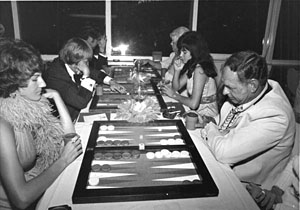|
| Magriel's NYT Columns |
 Every year, backgammon welcomes to its ranks thousands of newcomers eager to pick up the game. Unfortunately, though, it seems that most expert players often lack the patience and dedication required to instruct beginners, and serious backgammon teachers are sorely needed.
Every year, backgammon welcomes to its ranks thousands of newcomers eager to pick up the game. Unfortunately, though, it seems that most expert players often lack the patience and dedication required to instruct beginners, and serious backgammon teachers are sorely needed.
Owen Traynor of Fort Lauderdale, Fla., was a devoted teacher of backgammon who is credited with having instructed more new players than anyone else. Until his death at 67 this year, he was a well-known figure in the Fort Lauderdale-Miami area. For many years, he directed the Fort Lauderdale Backgammon Club. In addition, he was a familiar face at major international tournaments. When he wasn’t busy officiating, he took part as a player and was noted for a steady, conservative style of play.
The diagrammed position is taken from the finals of the 1970 Le Club International Backgammon Classic played between Traynor and Les Boyd. Traynor (Black) is well ahead in the race. His major problem now is to “clear” the 12-point — to bring these two men home without being hit by Boyd (White). This might well prove difficult as long as White has a stronghold on the 7-point.
|
| Black to play 6-3. |
Traynor resisted this temptation and correctly played 8/5, 8/2, clearing his 8-point instead.
|
|
|
In backgammon, it is not always wise to seek an immediate resolution to a problem. Sometimes the most prudent course of action is to simply wait patiently to see what will happen. In the game between Traynor and Boyd, Traynor was rewarded for not leaving his opponent an immediate shot. On his next play, he unexpectedly rolled 6-6, enabling him to clear the 12-point and easily win the race.
Rollout
 Tom Keith 2013 |
|
Money play Centered cube Black rolls 6-3 1296 games with VR Checker play: 2-ply Cube play: 3-ply Red |
| 6-3: | Game | G | BG | Equity | ||||
| 1 | 8/5, 8/2 |
W L |
.7130 .2870 |
.0145 .0040 |
.0002 .0001 | +0.7137 |

| (b) |
| 2 | 12/9, 12/6 |
W L |
.6163 .3837 |
.0092 .0144 |
.0002 .0003 | +0.3704 | (0.3433) | (a) |

|
|

